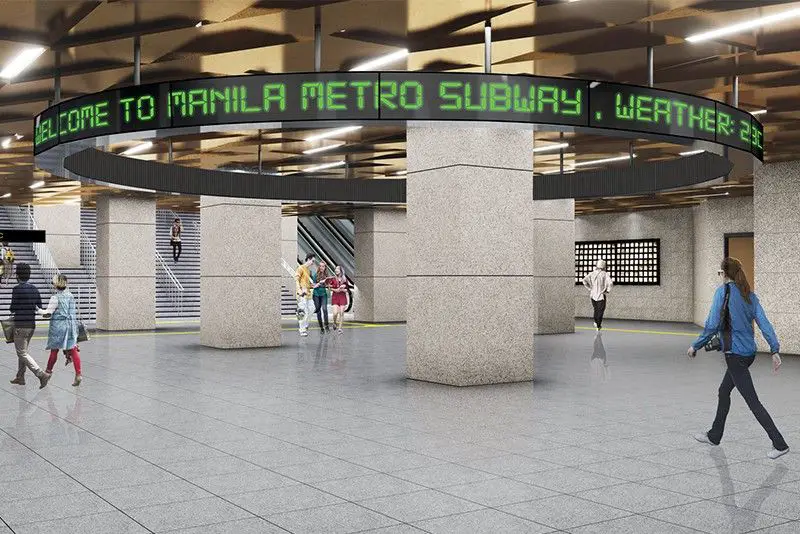The Metro Manila Subway project includes 17 stations from Valenzuela to Parañaque, aiming to serve 519,000 daily passengers with efficient connectivity and high operational capacity by 2029.
Key Takeaways
- Strategic locations for efficient passenger transfers and accessibility.
- Seamless integration with existing and future public transit networks.
- High train capacity, speed, and operational efficiency for 519,000 daily passengers.
- Projected partial operations by 2025 and full operations by 2029.
Subway Station Locations
Discover the strategic locations of the Metro Manila Subway stations along the 33.1km route from Valenzuela City to Bicutan, Parañaque City. The stations are strategically placed to serve key areas and facilitate efficient passenger transfers.
Each station plays a vital role in connecting different parts of Metro Manila, enhancing overall transportation accessibility. These locations are carefully selected to integrate with existing and future public transit networks, creating a seamless commuting experience for passengers.
As the project progresses, the specific number of stations along the line may change. The goal is to make sure that the Metro Manila Subway stations not only cater to the current transportation needs but also pave the way for future developments in the region.
Connecting Rail Lines
To understand the all-encompassing connectivity of the Metro Manila Subway system, it’s essential to explore how it seamlessly integrates with various existing rail lines in the metropolitan area.
The Grand Common Station will link the subway with LRT-1, MRT-3, and MRT-7 for seamless rail transfers. Anonas Station on the subway line will enhance interconnectivity by providing a connection to the LRT-2 system.
Additionally, the subway system will offer connections to the North-South Commuter Railway lines, easing travel between different cities in Luzon. This integration not only facilitates easy transfers between different rail lines but also allows passengers to switch to other modes of transportation like buses and jeepneys to reach their final destinations efficiently.
Train Quantity and Capacity
The Metro Manila Subway system will feature 30 eight-car train sets designed to accommodate passengers efficiently. Each of these train sets is capable of carrying up to 2,242 passengers, ensuring smooth and effectively transportation for commuters. The subway will operate at a design speed of 85 km/h, optimizing travel times across the city.
With a daily capacity of 519,000 passengers, the subway system will greatly improve public transportation in Metro Manila. The trains will run at an operational speed of 80 km/h, providing a rapid and reliable mode of transit for the city’s residents. Below is a table summarizing the key details of the Metro Manila Subway trains:
| Key Information | Values |
|---|---|
| Train Quantity | 30 eight-car train sets |
| Passenger Capacity | Up to 2,242 per train set |
| Design Speed | 85 km/h |
Operational Efficiency
For maximum efficiency, ensure that the Metro Manila Subway operates at its projected maximum speed of 120 km/h.
- Operational Speed: The subway aims for an operational speed of 80 km/h, enabling quick travel between stations.
- Wait Time: Target a 5-minute wait time between trains to provide reliable and timely service to passengers.
- Passenger Capacity: With a design to serve 519,000 passengers daily, the subway efficiently transports a large number of commuters.
Project Timeline and Completion
You should stay informed about the Metro Manila Subway project’s timeline and completion progress. The construction of the Metro Manila Subway commenced in February 2019, aiming for completion in phases, with full operations expected by 2029. Tunneling for the subway officially began in January 2023, and partial operations are projected to start in 2025.
However, delays have been encountered due to various challenges, impacting the project timeline. Staying updated on the Metro Manila Subway’s progress is essential to understanding the complexities involved in its construction and eventual completion.
| Project Milestone | Timeline |
|---|---|
| Construction start | February 2019 |
| Tunneling | January 2023 |
| Partial operations | 2025 |
| Full operations | 2029 |
Frequently Asked Questions
What Are the Stations of Metro Manila Subway?
You’ll find 17 stations along the Metro Manila Subway route from Valenzuela to Parañaque, with an extra branch to NAIA Terminal 3 in Pasay. The system promises a smooth ride, cutting travel times and accommodating hundreds of thousands daily.
What Are the Benefits of Metro Manila Subway?
You’ll enjoy shorter travel times, reduced traffic, and improved connectivity with the Metro Manila Subway. It will cater to 1 million daily passengers, boosting economic growth and development while offering advanced features for safety and efficiency.
How Much Is the Metro Manila Subway?
The Metro Manila Subway is estimated to cost ₱355.6 billion and is financed by a loan from JICA. It will span 33.1km, connect 17 stations by 2027, and accommodate 1.5 million passengers daily. Construction began in February 2019.
What Are the 9 Stations of Mrt?
You can find the 9 stations of MRT Line 9 strategically located to serve key areas, featuring modern facilities like platform screen doors for safety. These stations accommodate a large passenger volume during peak hours and integrate with existing transportation networks for enhanced connectivity.
Conclusion
You now have a better understanding of the Metro Manila Subway project.
With its strategic station locations, connections to existing rail lines, efficient train capacity, and planned completion by 2027, this subway system will greatly improve transportation in the region.
Keep an eye on this project for updates as it progresses towards enhancing the daily commute for millions of passengers in Metro Manila.
